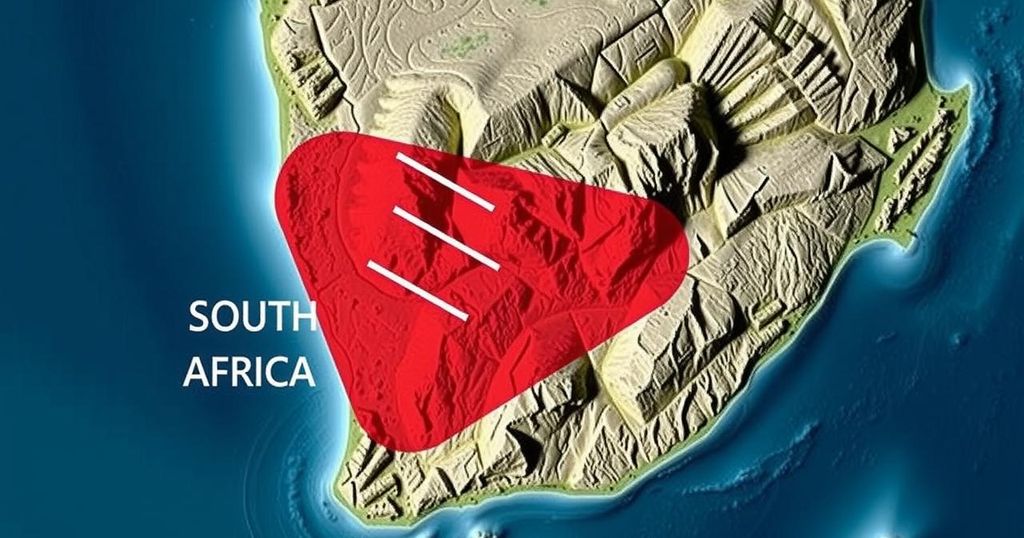A magnitude 5.3 earthquake struck South Africa on December 22, 2024, alarming residents. Centered near Brandvlei, the quake was felt as far as Cape Town and Namibia. Initial reports indicated no casualties or severe damage, yet experts highlighted a need for improved preparedness and infrastructure resilience in the wake of this rare seismic event.
On December 22, 2024, a magnitude 5.3 earthquake struck South Africa at 2:51 AM local time, causing distress among residents and prompting discussions on the nation’s preparedness for such seismic events. The quake originated approximately 101 kilometers west of Brandvlei in the Northern Cape province at a depth of 10 kilometers, as noted by the United States Geological Survey (USGS). The tremor was perceptible in several regions, including Cape Town, located roughly 250 kilometers away, and it even reached parts of Namibia, indicating its considerable impact.
Fortunately, initial reports indicate no casualties or significant damage, though assessments continue to gauge the earthquake’s influence on infrastructure and overall safety. The occurrence highlights the rarity of significant seismic activity in South Africa, with residents reporting varying degrees of disturbance. A local citizen from the City Bowl area remarked, “It was terrifying. We weren’t ready for something like this at all.”
This particular quake falls on the moderate end of the scale, recognized for causing light damage under specific circumstances. The discussion surrounding the Richter scale’s implications raises important questions about urban preparedness. Despite South Africa’s geological features aiding its resilience to earthquakes, experts emphasize the necessity for improved readiness as geological events are unpredictable. Dr. Lesley Steyn, a geologist at the University of Cape Town, noted, “The reality is, South Africa needs to be more prepared for these occurrences, even if they are less frequent.”
While no severe damage was reported, such as building collapses or widespread evacuations, lessons from this quake underline the importance of maintaining and enhancing infrastructure resiliency. Many older structures without modern earthquake-resistant designs remain vulnerable. Previous seismic incidents reinforce the call for proactive measures aimed at bolstering public safety and disaster response.
Adopting strategies from countries with robust disaster response frameworks, such as Japan, could guide South Africa in establishing more effective preparedness protocols. Implementing updated building codes and investing in seismic monitoring systems are critical steps towards enhancing the nation’s resilience. Community involvement, particularly through educational programs on emergency protocols and earthquake drills, is essential for fostering collective preparedness.
Furthermore, regional collaboration and international partnerships can lead to significant advancements in foundational safety practices. Emphasizing a shared approach to disaster readiness can bolster South Africa’s ability to navigate potential seismic threats more effectively. In light of this recent earthquake, it represents an urgent call for sustained vigilance and improvement in the nation’s overall disaster management strategies.
Understanding the geology of South Africa reveals that significant earthquakes are uncommon; however, occurrences can arise unexpectedly, prompting necessary evaluations of preparedness measures. The magnitude 5.3 earthquake experienced on December 22 serves as a reminder that despite a history of limited seismic disruptions, attention must be allocated towards enhancing infrastructure resilience and public education regarding earthquake safety. This incident provides an opportunity to re-examine urban planning, disaster response strategies, and community engagement to ensure higher levels of readiness for future events.
In summary, the magnitude 5.3 earthquake on December 22, 2024, serves as a crucial opportunity for South Africa to reassess and improve its earthquake preparedness and infrastructure resilience. Despite the absence of severe damage or casualties, the event underscores the ongoing need for public education, updated building codes, and community involvement in disaster response initiatives. By adopting proactive measures and learning from global best practices, South Africa can bolster its capabilities to manage potential seismic threats effectively.
Original Source: evrimagaci.org






